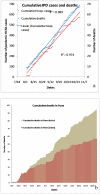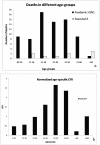Pandemic influenza (H1N1) 2009 is associated with severe disease in India
- PMID: 20479875
- PMCID: PMC2866330
- DOI: 10.1371/journal.pone.0010540
Pandemic influenza (H1N1) 2009 is associated with severe disease in India
Abstract
Background: Pandemic influenza A (H1N1) 2009 has posed a serious public health challenge world-wide. In absence of reliable information on severity of the disease, the nations are unable to decide on the appropriate response against this disease.
Methods: Based on the results of laboratory investigations, attendance in outpatient department, hospital admissions and mortality from the cases of influenza like illness from 1 August to 31 October 2009 in Pune urban agglomeration, risk of hospitalization and case fatality ratio were assessed to determine the severity of pandemic H1N1 and seasonal influenza-A infections.
Results: Prevalence of pandemic H1N1 as well as seasonal-A cases were high in Pune urban agglomeration during the study period. The cases positive for pandemic H1N1 virus had significantly higher risk of hospitalization than those positive for seasonal influenza-A viruses (OR: 1.7). Of 93 influenza related deaths, 57 and 8 deaths from Pune (urban) and 27 and 1 death from Pune (rural) were from pandemic H1N1 positive and seasonal-A positive cases respectively. The case fatality ratio 0.86% for pandemic H1N1 was significantly higher than that of seasonal-A (0.13%) and it was in category 3 of the pandemic severity index of CDC, USA. The data on the cumulative fatality of rural and urban Pune revealed that with time the epidemic is spreading to rural areas.
Conclusions: The severity of the H1N1 influenza pandemic is less than that reported for 'Spanish flu 1918' but higher than other pandemics of the 20(th) century. Thus, pandemic influenza should be considered as serious health threat and unprecedented global response seems justified.
Conflict of interest statement
Figures





References
-
- World Health Organization Pandemic H1N1 2009 update 78. 2009. http://www.who.int/csr/disease/swineflu/en/index.html. Accessed on 11 December.
-
- Fox M. 2009. Swine flu death rate similar to seasonal flu. Sep 16, 2009; at http://www.reuters.com/article/idUSTRE58E6NZ20090916. Accessed on 11 December 2009.
-
- Wang TT, Palese P. Unraveling the mystery of swine influenza virus. Cell. 2009;137:983–5. - PubMed
-
- Collignon P. Take a deep breath Swine flu is not that bad. Australasian Emergency Nursing Journal. 2009;12:71–72.
Publication types
MeSH terms
LinkOut - more resources
Full Text Sources
Medical

